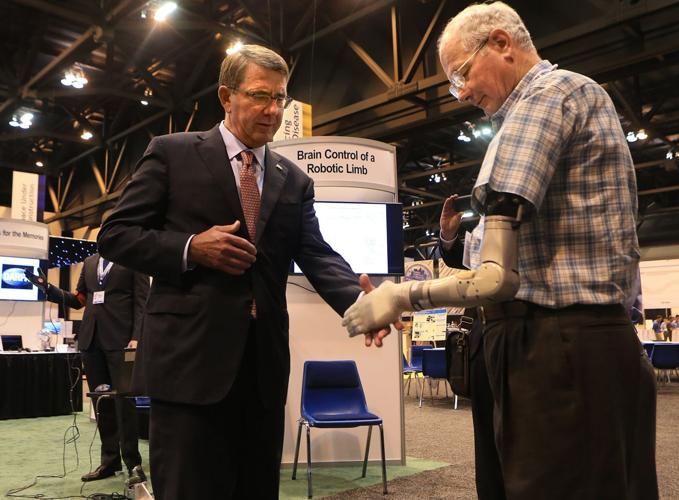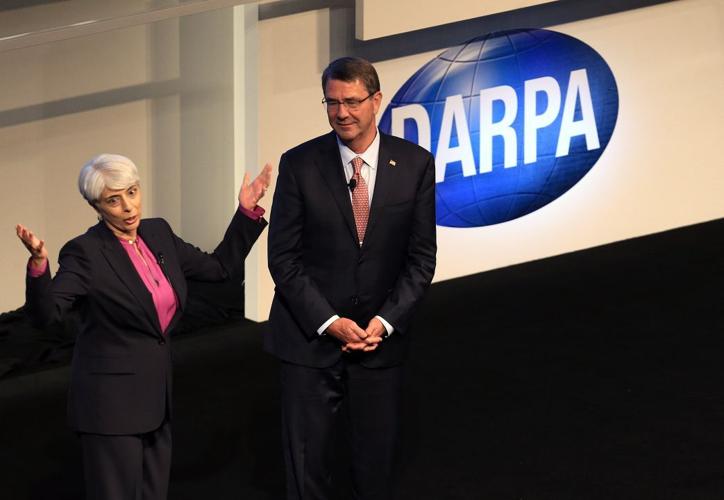ST. LOUIS • Secretary of Defense Ash Carter was speaking to his own crowd here Wednesday when he addressed an auditorium full of engineers, scientists, business leaders and military personnel, few in uniform. They gave him a standing ovation before he even got started.
If only Congress had the money to fund many of the cutting-edge projects members of the crowd were passionate about.
“This audience represents one of America’s great strengths, the fusion of our national security endeavor at the defense department and the wonderful, innovative open technology community, companies and universities that have done so much for this country,” Carter said from a stage at America’s Center downtown.
Carter, a physicist, was here to kick off a three-day event titled “Wait. What? A Future Technology Forum.” It’s hosted by the Defense Advanced Research Projects Agency, or DARPA, the arm of the U.S. government that helped create the Internet and other systems that became mainstream.
People are also reading…
His speech was part of his continued push — and sales pitch — to mold the military into a more technologically savvy force that can better adapt to modern warfare.
Past wars relied heavily on brute force technologies for equipment such as ships, tanks and bombers. But, for instance, it can take about 20 years to design and build a new fleet of fighter jets. Amid expectations to cut military spending and the rising threat of cyberwarfare and biological outbreaks, the defense department is looking for ways to develop lighter technologies faster.
Carter called on continued help from companies such as Boeing, which he visited here before the speech, but also commercial startups that haven’t worked with the government.
“The (defense department) has to tap into all streams of innovation and emerging technology,” he said. “And it has to do so much more quickly.”
Since being sworn in in February, Carter’s stance on the future force has made waves amid legacy contractors and companies that historically avoided dealing with government red tape.
Last spring at Stanford University, he announced the defense department would open a new office in Silicon Valley to focus on cyberthreats to national security. In August, also in Silicon Valley, he awarded $75 million to a consortium of 162 companies, academics and other groups that is supposed to develop flexible electronics and sensors that can be molded onto soldier uniforms or aircraft.
In his speech for that announcement, Carter acknowledged a disconnect between new-growth tech companies and the defense department.
“Sometimes we disagree,” he said, according to the Associated Press. “Addressing disagreements through partnership is better than not speaking at all.”
Meanwhile, legacy industry leaders have warned that quick turnarounds often aren’t feasible in the field of military contracting.
“Silicon Valley folks? Their main focus is on speed to market,” Michael Daly, chief technology officer for Raytheon Cybersecurity and Special Missions told Politico in July. “When you’re making technology in the defense market, you also have to address other aspects, including mission assurance, acquisition compliance — these things are important … there’s an overhead to that. That can slow you down if you’re not structured to deal with it.”
At a news conference here Wednesday, Carter said there needs to be a balance.
“We want to have an association of new companies and old companies,” he said.
He stressed that there needs to more “rapid seed funding” offered through DARPA for “better speed and agility” in creating the “force of the future.”
“We can’t move at Washington speed or bureaucracy speed when the innovators and the companies that are doing innovation are moving much faster than that,” he said, adding that “carefully and slowly doesn’t have to be the same thing.”
Asked about the next frontier of threats, Carter said he suspected bio sciences will be the most consequential, not information technology.
“Like all technologies, they will be used for good or ill and our job is to make sure the uses for good outweigh the uses for ill,” he said.
Dozens of DARPA-funded projects are being demonstrated at the forum, which isn’t open to the public (tickets sold out).
The projects, many in developmental stages, include a brain controlled prosthetic, a portable medical lab test kit that can give immediate results, and a handheld radiation sensor. Also on display is an Anti-Submarine Warfare Continuous Trail Unmanned Vessel, an automated watercraft that is supposed to be able to track submarines for thousands of miles.
Leidos, a private contractor from Reston, Va., is working on the project with DARPA. A small replica is on hand for the forum, which seems like a good place for a spy to show up.
“The secret sauce is in the software, and we aren’t showing that,” said Dave Antanitus, a retired rear admiral who now works in business development for Leidos.
Another project seemed to represent Carter’s call for collaboration between professions. The Soft Exosuit is a combination of electronics, cloth, and cable that when worn helps soldiers carry heavy loads over a long distance.
“It’s a really multidisciplinary product,” said Conor Walsh, a biomedical engineer at Harvard who has been a part of the contract, along with other people with backgrounds in robotics, physiology and other fields of study.









